Two Novel C-Terminus RUNX2 Mutations in Two Cleidocranial Dysplasia (CCD) Patients Impairing p53 Expression
Abstract
1. Introduction
2. Results
2.1. Clinical Data
2.2. RUNX2 Mutations
2.3. Modulation of RUNX2 and SPARC Expression in Pt2 cMSCs during Osteogenic Differentiation
2.4. Osteogenically-Stimulated CCD Fibroblasts Express High Levels of RUNX2 Protein
2.5. P53 and PTEN Expression Are Reduced in CCD Os-Fibroblasts
3. Discussion
4. Material and Methods
4.1. Patients
4.2. Circulating Mesenchymal Stem Cells (cMSCs)
4.3. Analysis of Cell Phenotype
4.4. Fibroblasts
4.5. DNA Extraction
4.6. Sanger Sequencing
4.7. RNA Extraction
4.8. Reverse Transcription and Real Time PCR
4.9. Digital Droplet PCR
4.10. Protein Extraction and Western Blot
4.11. Alizarin Red Staining
4.12. Statistical Analysis
5. Conclusions
Author Contributions
Funding
Institutional Review Board Statement
Informed Consent Statement
Data Availability Statement
Acknowledgments
Conflicts of Interest
References
- Machol, K.; Mendoza-Londono, R.; Lee, B. Cleidocranial dysplasia spectrum disorder. In GeneReviews®; University of Washington: Seattle, WA, USA, 2017; Bookshelf ID: NBK1513. [Google Scholar]
- Bir, F.D.; Dinçkan, N.; Güven, Y.; Baş, F.; Altunoglu, U.; Kuvvetli, S.S.; Poyrazoglu, S.; Toksoy, G.; Kayserili, H.; Uyguner, Z.O. Cleidocranial dysplasia: Clinical, endocrinologic and molecular findings in 15 patients from 11 families. Eur. J. Med. Genet. 2017, 60, 163–168. [Google Scholar]
- Jamali, E.; Khalesi, R.; Bitarafan, F.; Almadani, N.; Garshasbi, M. Identification of a novel splice site mutation in RUNX2 gene in a family with rare autosomal dominant cleidocranial dysplasia. Iran Biomed. J. 2021, 25, 297–302. [Google Scholar] [PubMed]
- Carbonare, L.D.; Innamorati, G.; Valenti, M.T. Transcription factor Runx2 and its application to bone tissue engineering. Stem Cell Rev. Rep. 2012, 8, 891–897. [Google Scholar] [CrossRef] [PubMed]
- Otto, F.; Thornell, A.P.; Crompton, T.; Denzel, A.; Gilmour, K.; Rosewell, I.R.; Stamp, G.W.; Beddington, R.S.; Mundlos, S.; Olsen, B.R.; et al. Cbfa1, a candidate gene for cleidocranial dysplasia syndrome, is essential for osteoblast differentiation and bone development. Cell 1997, 89, 765–771. [Google Scholar] [CrossRef]
- Kim, H.J.; Kim, W.J.; Ryoo, H.M. Post-translational regulations of transcriptional activity of RUNX2. Mol. Cells 2020, 43, 160–167. [Google Scholar] [PubMed]
- Huang, G.; Shigesada, K.; Ito, K.; Wee, H.J.; Yokomizo, T.; Ito, Y. Dimerization with PEBP2beta protects RUNX1/AML1 from ubiquitin-proteasome-mediated degradation. EMBO J. 2001, 20, 723–733. [Google Scholar] [CrossRef] [PubMed]
- Komori, T. Regulation of bone development and extracellular matrix protein genes by RUNX2. Cell Tissue Res. 2010, 339, 189–195. [Google Scholar] [CrossRef] [PubMed]
- Otto, F.; Kanegane, H.; Mundlos, S. Mutations in the RUNX2 gene in patients with cleidocranial dysplasia. Hum. Mutat. 2002, 19, 209–216. [Google Scholar] [CrossRef] [PubMed]
- Mundlos, S.; Otto, F.; Mundlos, C.; Mulliken, J.B.; Aylsworth, A.S.; Albright, S.; Lindhout, D.; Cole, W.G.; Henn, W.; Knoll, J.H.; et al. Mutations involving the transcription factor CBFA1 cause cleidocranial dysplasia. Cell 1997, 89, 773–779. [Google Scholar] [CrossRef]
- Yoshida, T.; Kanegane, H.; Osato, M.; Yanagida, M.; Miyawaki, T.; Ito, Y.; Shigesada, K. Functional analysis of RUNX2 mutations in Japanese patients with cleidocranial dysplasia demonstrates novel genotype-phenotype correlations. Am. J. Hum. Genet. 2002, 71, 724–738. [Google Scholar] [CrossRef]
- Papadopoulou, A.; Bountouvi, E.; Sideri, V.; Moutsatsou, P.; Skarakis, N.S.; Doulgeraki, A.; Karachaliou, F.E. Parietal aplasia and hypophosphatasia in a child harboring a novel mutation in RUNX2 and a likely pathogenic variant in TNSALP. Bone 2021, 146, 115904. [Google Scholar] [CrossRef] [PubMed]
- Ott, C.E.; Leschik, G.; Trotier, F.; Brueton, L.; Brunner, H.G.; Brussel, W.; Guillen-Navarro, E.; Haase, C.; Kohlhase, J.; Kotzot, D.; et al. Deletions of the RUNX2 gene are present in about 10% of individuals with cleidocranial dysplasia. Hum. Mutat. 2010, 31, E1587–E1593. [Google Scholar] [CrossRef] [PubMed]
- Quack, I.; Vonderstrass, B.; Stock, M.; Aylsworth, A.S.; Becker, A.; Brueton, L.; Lee, P.J.; Majewski, F.; Mulliken, J.B.; Suri, M.; et al. Mutation analysis of core binding factor A1 in patients with cleidocranial dysplasia. Am. J. Hum. Genet. 1999, 65, 1268–1278. [Google Scholar] [CrossRef] [PubMed]
- Gao, X.; Li, K.; Fan, Y.; Sun, Y.; Luo, X.; Wang, L.; Liu, H.; Gong, Z.; Wang, J.; Wang, Y.; et al. Identification of RUNX2 variants associated with cleidocranial dysplasia. Hereditas 2019, 156, 1–9. [Google Scholar] [CrossRef] [PubMed]
- Zhang, Y.W.; Yasui, N.; Ito, K.; Huang, G.; Fujii, M.; Hanai, J.; Nogami, H.; Ochi, T.; Miyazono, K.; Ito, Y. A RUNX2/PEBP2alpha A/CBFA1 mutation displaying impaired transactivation and Smad interaction in cleidocranial dysplasia. Proc. Natl. Acad. Sci. USA 2000, 97, 10549–10554. [Google Scholar] [CrossRef]
- Choi, J.Y.; Pratap, J.; Javed, A.; Zaidi, S.K.; Xing, L.; Balint, E.; Dalamangas, S.; Boyce, B.; van Wijnen, A.J.; Lian, J.B.; et al. Subnuclear targeting of Runx/Cbfa/AML factors is essential for tissue-specific differentiation during embryonic development. Proc. Natl. Acad. Sci. USA 2001, 98, 8650–8655. [Google Scholar] [CrossRef]
- Kanno, T.; Kanno, Y.; Chen, L.F.; Ogawa, E.; Kim, W.Y.; Ito, Y. Intrinsic transcriptional activation-inhibition domains of the polyomavirus enhancer binding protein 2/core binding factor alpha subunit revealed in the presence of the beta subunit. Mol. Cell Biol. 1998, 18, 2444–2454. [Google Scholar] [CrossRef]
- Tang, L.; Guo, B.; Javed, A.; Choi, J.Y.; Hiebert, S.; Lian, J.B.; van Wijnen, A.J.; Stein, J.L.; Stein, G.S.; Zhou, G.W. Crystal structure of the nuclear matrix targeting signal of the transcription factor acute myelogenous leukemia-1/polyoma enhancer-binding protein 2alphaB/core binding factor alpha2. J. Biol. Chem. 1999, 274, 33580–33586. [Google Scholar] [CrossRef]
- Zeng, C.; van Wijnen, A.J.; Stein, J.L.; Meyers, S.; Sun, W.; Shopland, L.; Lawrence, J.B.; Penman, S.; Lian, J.B.; Stein, G.S.; et al. Identification of a nuclear matrix targeting signal in the leukemia and bone-related AML/CBF-alpha transcription factors. Proc. Natl. Acad. Sci. USA 1997, 94, 6746–6751. [Google Scholar] [CrossRef]
- Zeng, C.; McNeil, S.; Pockwinse, S.; Nickerson, J.; Shopland, L.; Lawrence, J.B.; Penman, S.; Hiebert, S.; Lian, J.B.; van Wijnen, A.J.; et al. Intranuclear targeting of AML/CBFalpha regulatory factors to nuclear matrix-associated transcriptional domains. Proc. Natl. Acad. Sci. USA 1998, 95, 1585–1589. [Google Scholar] [CrossRef]
- Zaidi, S.K.; Javed, A.; Choi, J.Y.; van Wijnen, A.J.; Stein, J.L.; Lian, J.B.; Stein, G.S. A specific targeting signal directs Runx2/Cbfa1 to subnuclear domains and contributes to transactivation of the osteocalcin gene. J. Cell Sci. 2001, 114, 3093–3102. [Google Scholar] [CrossRef]
- Young, D.W.; Zaidi, S.K.; Furcinitti, P.S.; Javed, A.; van Wijnen, A.J.; Stein, J.L.; Lian, J.B.; Stein, G.S. Quantitative signature for architectural organization of regulatory factors using intranuclear informatics. J. Cell Sci. 2004, 117, 4889–4896. [Google Scholar] [CrossRef] [PubMed]
- Schroeder, T.M.; Jensen, E.D.; Westendorf, J.J. Runx2: A master organizer of gene transcription in developing and maturing osteoblasts. Birth Defects Res. C Embryo. Today 2005, 75, 213–225. [Google Scholar] [CrossRef] [PubMed]
- Jaruga, A.; Hordyjewska, E.; Kandzierski, G.; Tylzanowski, P. Cleidocranial dysplasia and RUNX2-clinical phenotype-genotype correlation. Clin. Genet. 2016, 90, 393–402. [Google Scholar] [CrossRef] [PubMed]
- Wang, G.X.; Sun, R.P.; Song, F.L. A novel RUNX2 mutation (T420I) in Chinese patients with cleidocranial dysplasia. Genet. Mol. Res. 2010, 9, 41–47. [Google Scholar] [CrossRef] [PubMed]
- Bae, S.C.; Ogawa, E.; Maruyama, M.; Oka, H.; Satake, M.; Shigesada, K.; Jenkins, N.A.; Gilbert, D.J.; Copeland, N.G.; Ito, Y. PEBP2 alpha B/mouse AML1 consists of multiple isoforms that possess differential transactivation potentials. Mol. Cell Biol. 1994, 14, 3242–3252. [Google Scholar] [CrossRef] [PubMed]
- Bruderer, M.; Richards, R.G.; Alini, M.; Stoddart, M.J. Role and regulation of RUNX2 in osteogenesis. Eur. Cell Mater. 2014, 28, 269–286. [Google Scholar] [CrossRef]
- Jung, Y.J.; Bae, H.S.; Ryoo, H.M.; Baek, S.H. A novel RUNX2 mutation in exon 8, G462X, in a patient with Cleidocranial Dysplasia. J. Cell Biochem. 2018, 119, 1152–1162. [Google Scholar] [CrossRef]
- Rosset, E.M.; Bradshaw, A.D. SPARC/osteonectin in mineralized tissue. Matrix Biol. 2016, 52, 78–87. [Google Scholar] [CrossRef] [PubMed]
- Gruber, H.E.; Sage, E.H.; Norton, H.J.; Funk, S.; Ingram, J.; Hanley, E.N., Jr. Targeted deletion of the SPARC gene accelerates disc degeneration in the aging mouse. J. Histochem. Cytochem. 2005, 53, 1131–1138. [Google Scholar] [CrossRef] [PubMed]
- do Reis, L.M.; Kessler, C.B.; Adams, D.J.; Lorenzo, J.; Jorgetti, V.; Delany, A.M. Accentuated osteoclastic response to parathyroid hormone undermines bone mass acquisition in osteonectin-null mice. Bone 2008, 43, 264–273. [Google Scholar] [CrossRef] [PubMed][Green Version]
- Seidman, J.G.; Seidman, C. Transcription factor haploinsufficiency: When half a loaf is not enough. J. Clin. Invest. 2002, 109, 451–455. [Google Scholar] [CrossRef]
- Zanatta, M.; Valenti, M.T.; Donatelli, L.; Zucal, C.; Dalle Carbonare, L. Runx-2 gene expression is associated with age-related changes of bone mineral density in the healthy young-adult population. J. Bone. Miner. Metab. 2012, 30, 706–714. [Google Scholar] [CrossRef]
- Glastre, C.; Braillon, P.; David, L.; Cochat, P.; Meunier, P.J.; Delmas, P.D. Measurement of bone mineral content of the lumbar spine by dual energy x-ray absorptiometry in normal children: Correlations with growth parameters. J. Clin. Endocrinol. Metab. 1990, 70, 1330–1333. [Google Scholar] [CrossRef]
- Valenti, M.T.; Mottes, M.; Cheri, S.; Deiana, M.; Micheletti, V.; Cosaro, E.; Davì, M.V.; Francia, G.; Dalle Carbonare, L. Runx2 overexpression compromises bone quality in acromegalic patients. Endocr. Relat. Cancer 2018, 25, 269–277. [Google Scholar] [CrossRef]
- Dalle Carbonare, L.; Micheletti, V.; Cosaro, E.; Valenti, M.T.; Mottes, M.; Francia, G.; Davì, M.V. Bone histomorphometry in acromegaly patients with fragility vertebral fractures. Pituitary 2018, 21, 56–64. [Google Scholar] [CrossRef]
- Tataria, M.; Quarto, N.; Longaker, M.T.; Sylvester, K.G. Absence of the p53 tumor suppressor gene promotes osteogenesis in mesenchymal stem cells. J. Pediatr. Surg. 2006, 41, 624–632. [Google Scholar] [CrossRef] [PubMed]
- Zhou, X.; Beilter, A.; Xu, Z.; Gao, R.; Xiong, S.; Paulucci-Holthauzen, A.; Lozano, G.; de Crombrugghe, B.; Gorlick, R. Wnt/ß-catenin-mediated p53 suppression is indispensable for osteogenesis of mesenchymal progenitor cells. Cell Death Dis. 2021, 12, 1–13. [Google Scholar] [CrossRef]
- Deiana, M.; Carbonare, L.D.; Serena, M.; Cheri, S.; Parolini, F.; Gandini, A.; Marchetto, G.; Innamorati, G.; Manfredi, M.; Marengo, E.; et al. New insights into the runt domain of RUNX2 in melanoma cell proliferation and migration. Cells 2018, 7, 220. [Google Scholar] [CrossRef]
- Ozaki, T.; Wu, D.; Sugimoto, H.; Nagase, H.; Nakagawara, A. Runt-related transcription factor 2 (RUNX2) inhibits p53-dependent apoptosis through the collaboration with HDAC6 in response to DNA damage. Cell Death Dis. 2013, 4, e610. [Google Scholar] [CrossRef] [PubMed]
- Stambolic, V.; MacPherson, D.; Sas, D.; Lin, Y.; Snow, B.; Jang, Y.; Benchimol, S.; Mak, T.W. Regulation of PTEN transcription by p53. Mol Cell. 2001, 8, 317–325. [Google Scholar] [CrossRef]
- Thoma, S.J.; Lamping, C.P.; Ziegler, B.L. Phenotype analysis of hematopoietic CD34+ cell populations derived from human umbilical cord blood using flow cytometry and cDNA-polymerase chain reaction. Blood 1994, 83, 2103–2114. [Google Scholar] [CrossRef]
- Kawazoe, Y.; Shiba, T.; Nakamura, R.; Mizuno, A.; Tsutsumi, K.; Uematsu, T.; Yamaoka, M.; Shindoh, M.; Kohgo, T. Induction of calcification in MC3T3-E1 cells by inorganic polyphosphate. J. Dent. Res. 2004, 83, 613–618. [Google Scholar] [CrossRef]
- Carbonare, L.D.; Mottes, M.; Cheri, S.; Deiana, M.; Zamboni, F.; Gabbiani, D.; Schena, F.; Salvagno, G.L.; Lippi, G.; Valenti, M.T. Increased gene expression of RUNX2 and SOX9 in mesenchymal circulating progenitors is associated with autophagy during physical activity. Oxid. Med. Cell Longev. 2019, 15, 8426259. [Google Scholar] [CrossRef]
- Vandesompele, J.; De Preter, K.; Pattyn, F.; Poppe, B.; Van Roy, N.; De Paepe, A.; Speleman, F. Accurate normalization of real-time quantitative RT-PCR data by geometric averaging of multiple internal control genes. Genome Biol. 2002, 3, 1–12. [Google Scholar] [CrossRef]
- Dalle Carbonare, L.; Bertacco, J.; Marchetto, G.; Cheri, S.; Deiana, M.; Minoia, A.; Tiso, N.; Mottes, M.; Valenti, M.T. Methylsulfonylmethane enhances MSC chondrogenic commitment and promotes pre-osteoblasts formation. Stem Cell Res. Ther. 2021, 12, 1–12. [Google Scholar] [CrossRef]
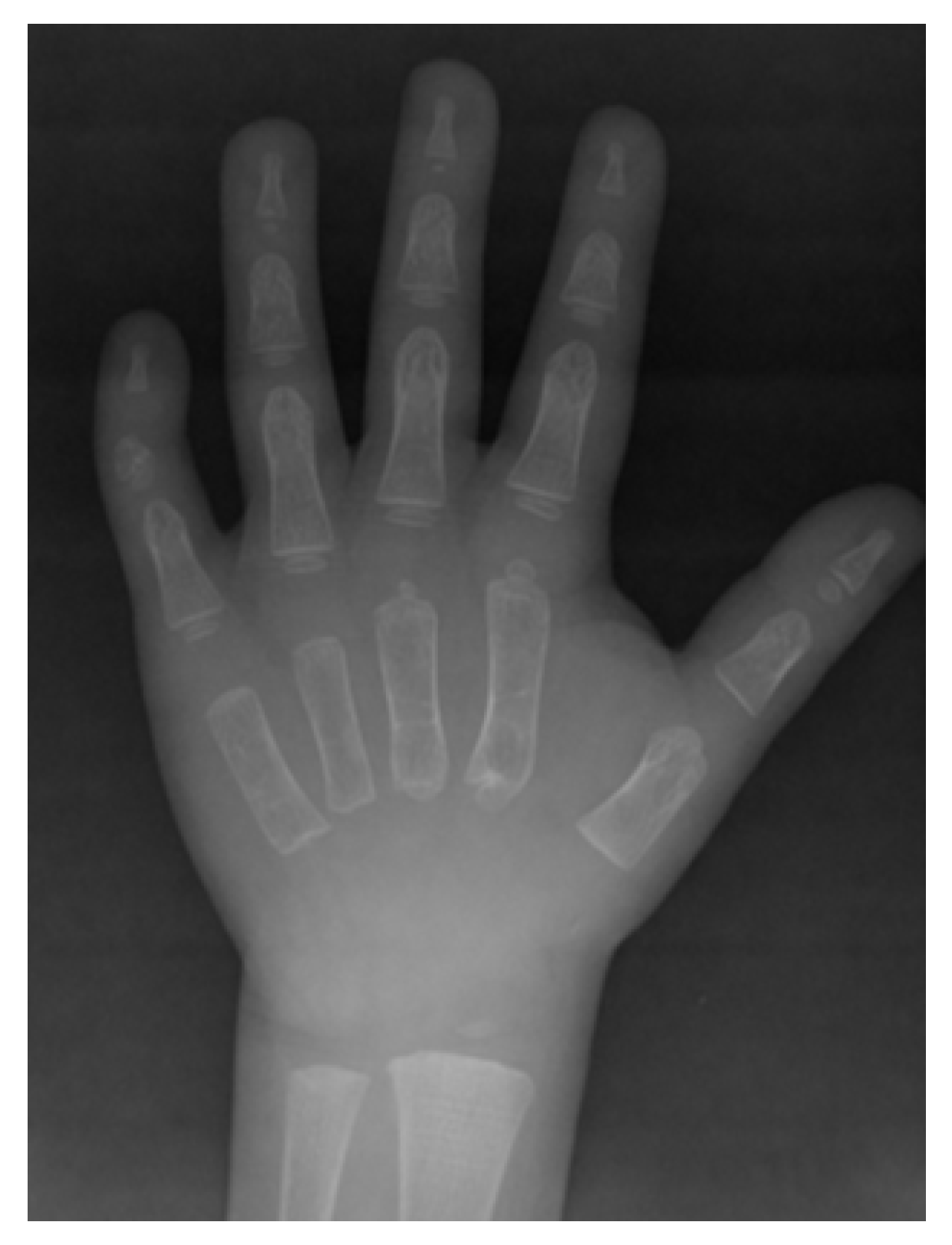
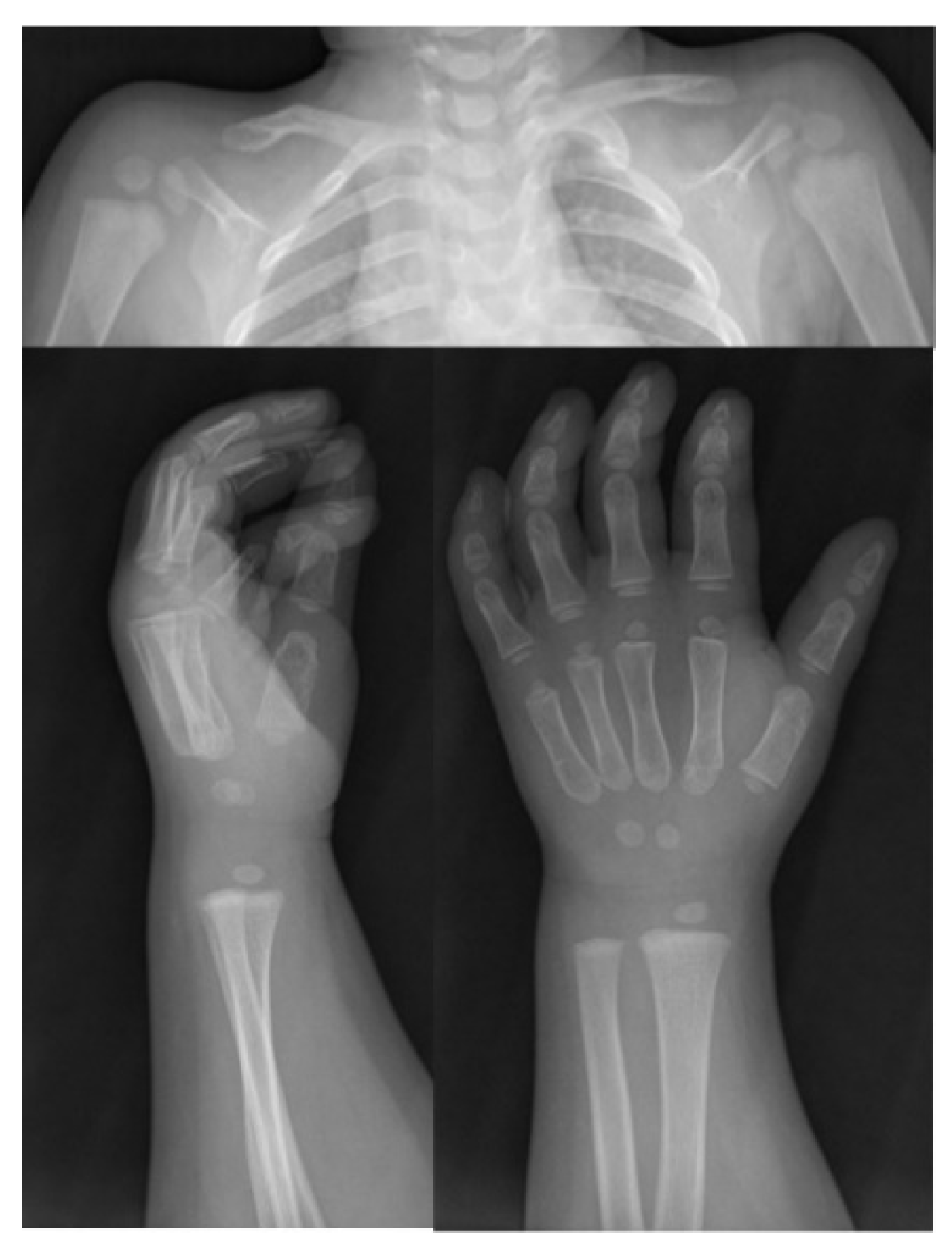
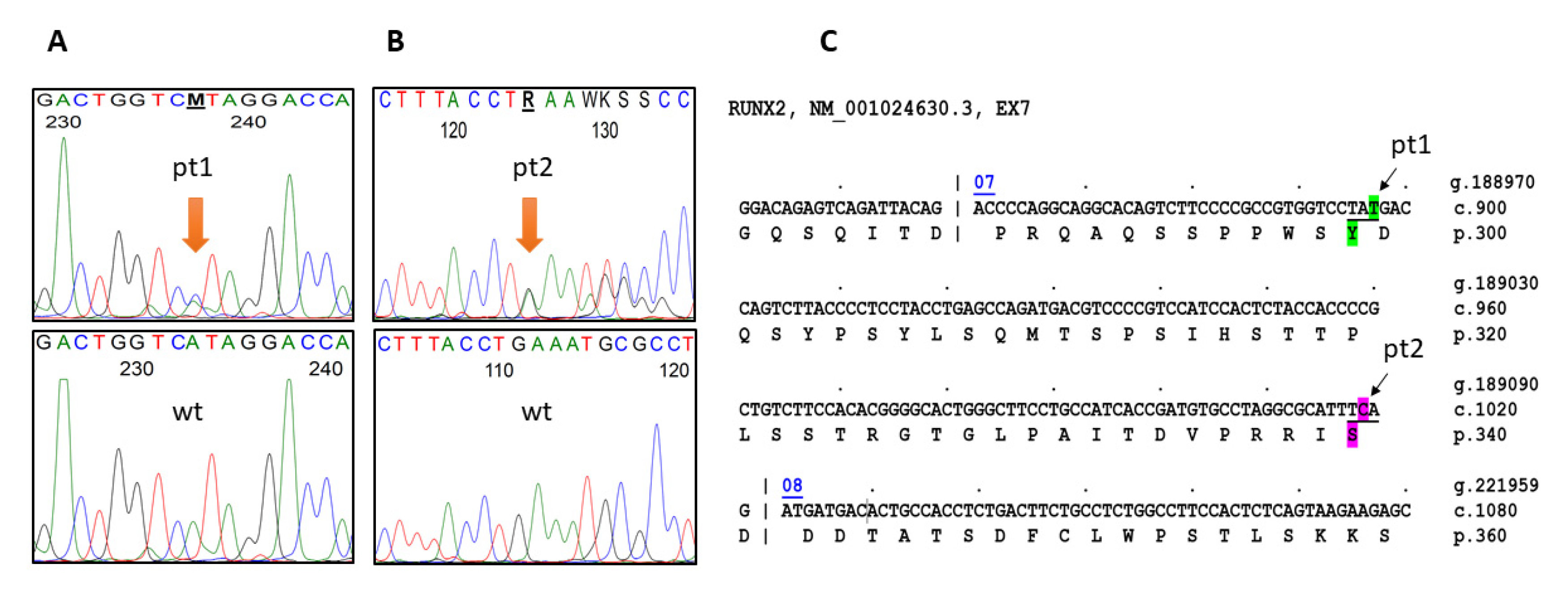

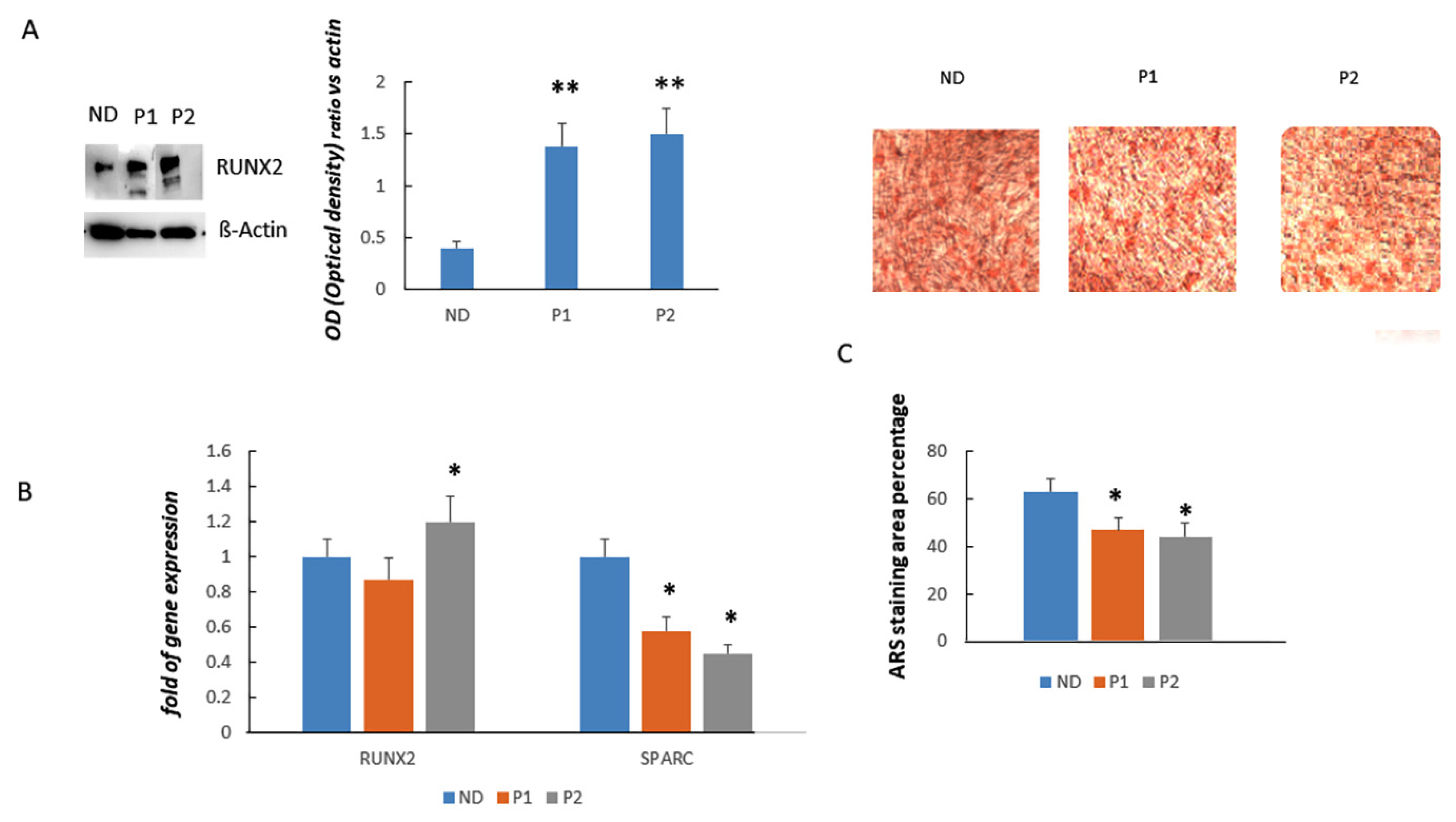
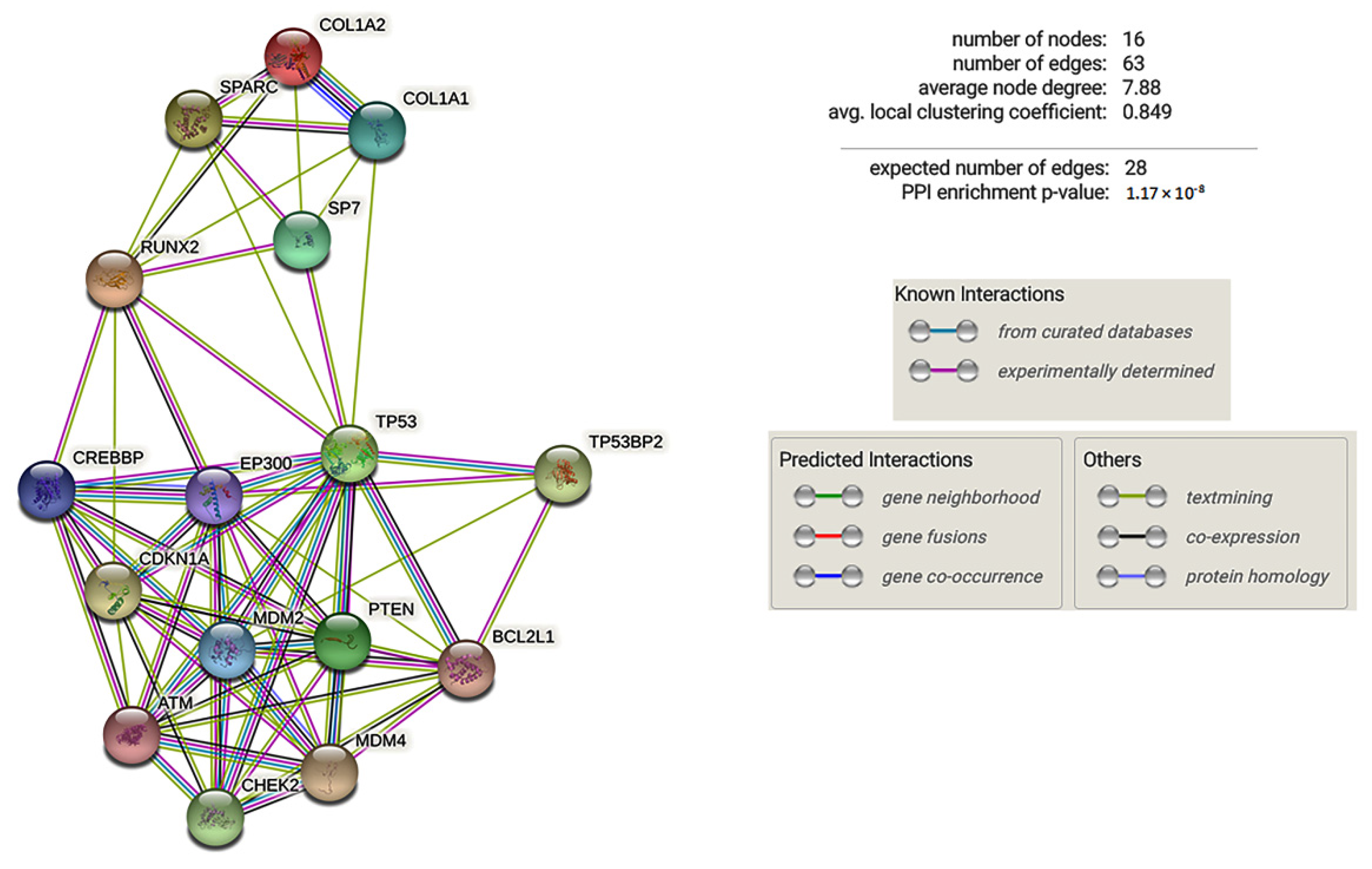
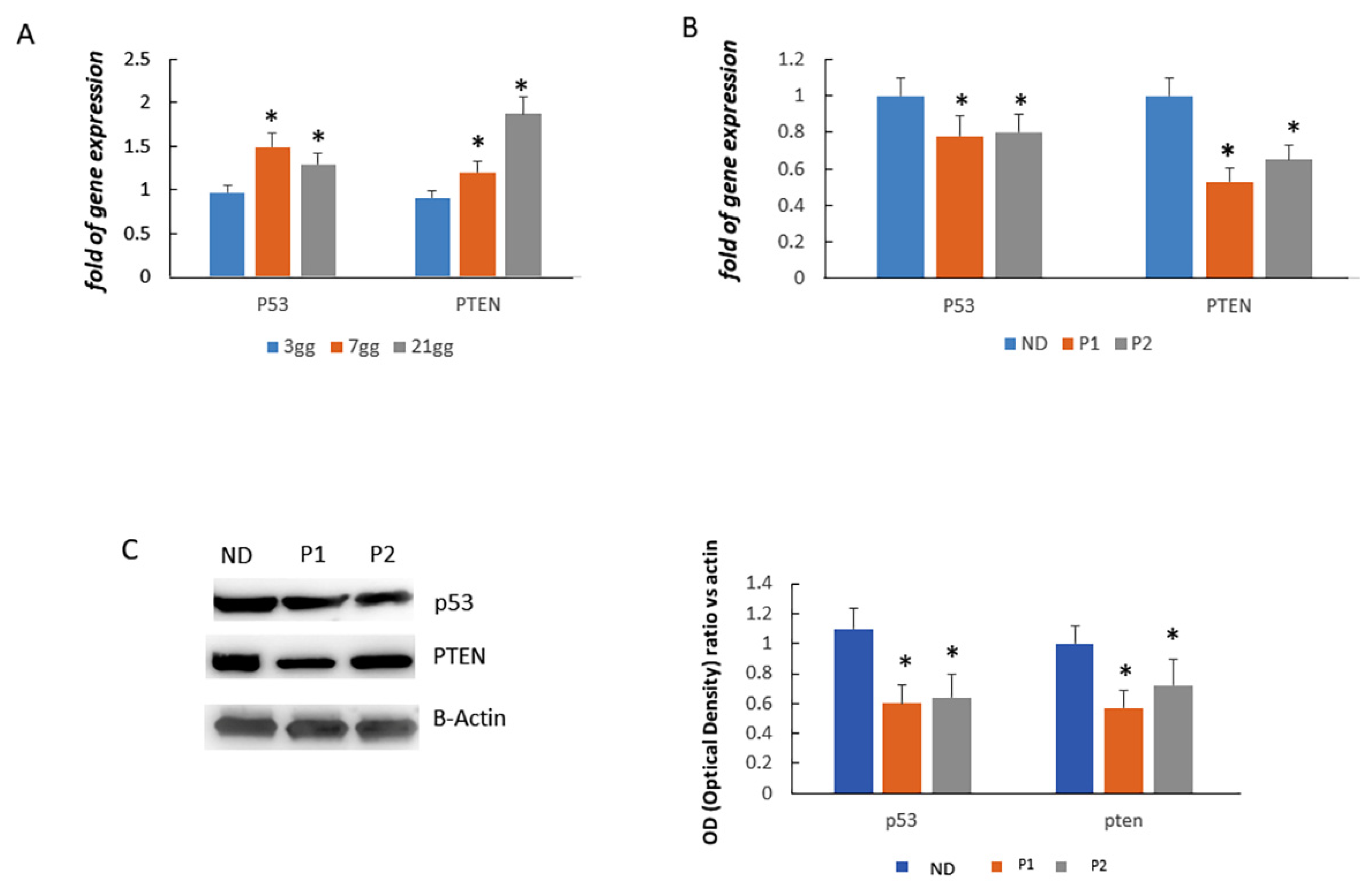
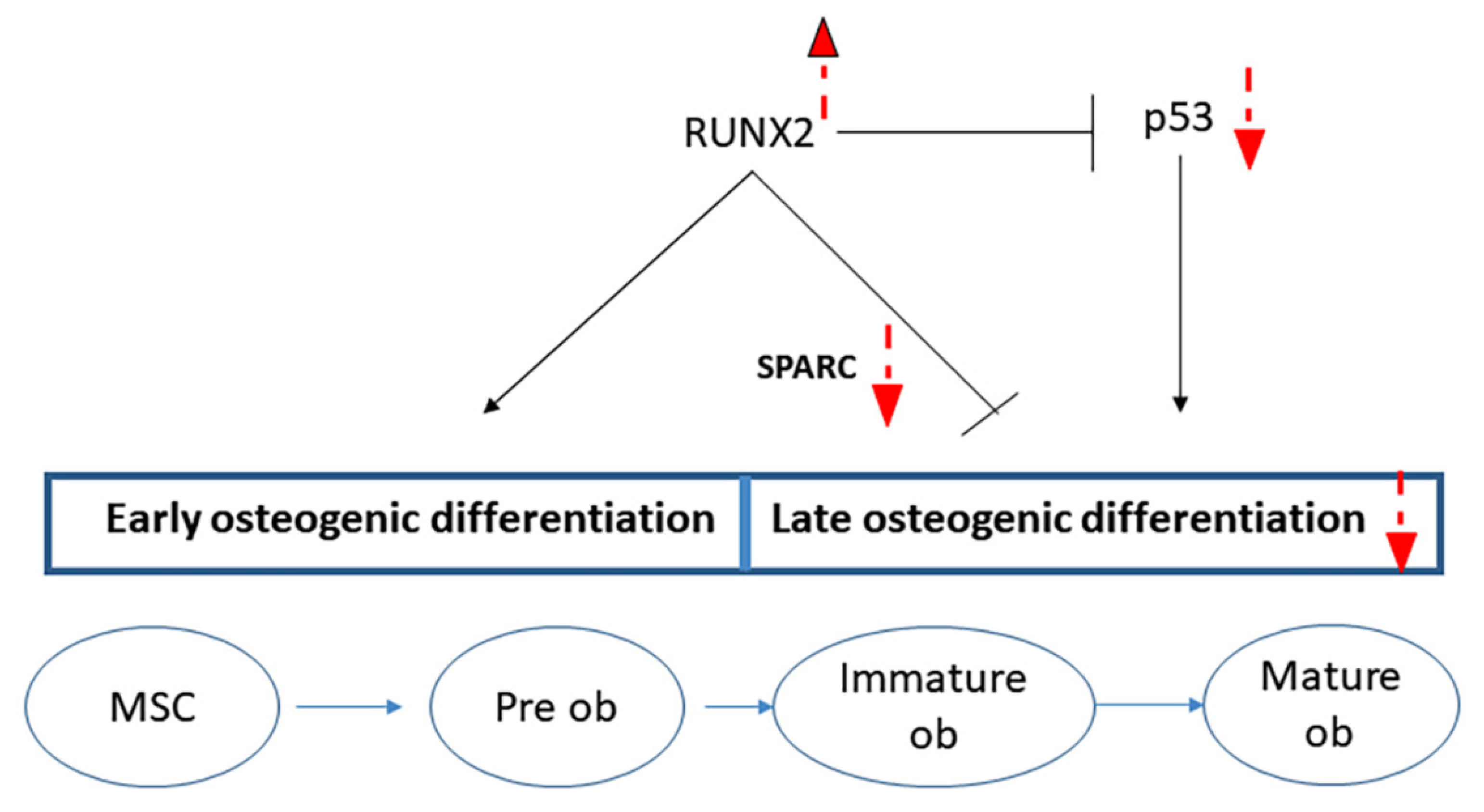
Publisher’s Note: MDPI stays neutral with regard to jurisdictional claims in published maps and institutional affiliations. |
© 2021 by the authors. Licensee MDPI, Basel, Switzerland. This article is an open access article distributed under the terms and conditions of the Creative Commons Attribution (CC BY) license (https://creativecommons.org/licenses/by/4.0/).
Share and Cite
Dalle Carbonare, L.; Antoniazzi, F.; Gandini, A.; Orsi, S.; Bertacco, J.; Li Vigni, V.; Minoia, A.; Griggio, F.; Perduca, M.; Mottes, M.; et al. Two Novel C-Terminus RUNX2 Mutations in Two Cleidocranial Dysplasia (CCD) Patients Impairing p53 Expression. Int. J. Mol. Sci. 2021, 22, 10336. https://doi.org/10.3390/ijms221910336
Dalle Carbonare L, Antoniazzi F, Gandini A, Orsi S, Bertacco J, Li Vigni V, Minoia A, Griggio F, Perduca M, Mottes M, et al. Two Novel C-Terminus RUNX2 Mutations in Two Cleidocranial Dysplasia (CCD) Patients Impairing p53 Expression. International Journal of Molecular Sciences. 2021; 22(19):10336. https://doi.org/10.3390/ijms221910336
Chicago/Turabian StyleDalle Carbonare, Luca, Franco Antoniazzi, Alberto Gandini, Silvia Orsi, Jessica Bertacco, Veronica Li Vigni, Arianna Minoia, Francesca Griggio, Massimiliano Perduca, Monica Mottes, and et al. 2021. "Two Novel C-Terminus RUNX2 Mutations in Two Cleidocranial Dysplasia (CCD) Patients Impairing p53 Expression" International Journal of Molecular Sciences 22, no. 19: 10336. https://doi.org/10.3390/ijms221910336
APA StyleDalle Carbonare, L., Antoniazzi, F., Gandini, A., Orsi, S., Bertacco, J., Li Vigni, V., Minoia, A., Griggio, F., Perduca, M., Mottes, M., & Valenti, M. T. (2021). Two Novel C-Terminus RUNX2 Mutations in Two Cleidocranial Dysplasia (CCD) Patients Impairing p53 Expression. International Journal of Molecular Sciences, 22(19), 10336. https://doi.org/10.3390/ijms221910336










